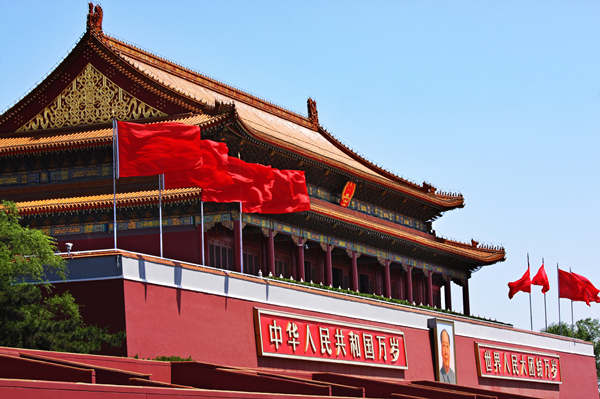 图片@视觉中国
图片@视觉中国
Above the archway hangs a large portrait of Maozedong, on the east and west sides of which are two giant placards, the left one reading: "Long Live the People's Republic of China" while the right one reading: "Long Live the Great Unity of the World's Peoples." In front of the Tiananmen Tower is golden water bridge, above which spans 7 white marble bridges with fine carvings. Same as the arch gateways, the central bridge as the widest one was reserved for the emperor. In front of the central arch gateway are two a pair of stone columns, called huabiao, each weighs 10 ton and reaches about 10m. The two columns are carved with dragon design and have an animal "Wangtianhou" on top as decoration. Outside the gate there are two lions and two more guarding the bridges. Lions are believed to protect humans from evil spirits in Chinese culture. On the south of Tiananmen extends the No. 1 Street of Beijing, Chang'an Street, further south of which is the largest square in the world, Tiananmen Square. The tower sitting on the platform is a structure with double-eaved roof and yellow-glazed tiles. It is made 9 bays wide and 5 bays deep, which indicates the supremacy of the emperor.
 图片@视觉中国
图片@视觉中国
On the two sides of the stone lions are reviewing stands. It was opened up to the public on the first day of 2012. Five thousand visitors were lucky to step up there and view the national flag rising that day. That was the first time the stands open up free to the public for since January 1, 1988. The reviewing stands now are available to group reservations for the opening day on the first day of each month. Only group reservations via local travel agencies are acceptable and should be submitted online before the 15th day of the previous month.
 图片@视觉中国
图片@视觉中国
Constructed during the reign of Ming Yongle in 1420, the tower has been destroyed and rebuilt several times. Originally, it was a three-storey timberwork in the form of paifang of the imperial building named Gate of Accepting Heavenly Mandate (Chengtian Gate).
 图片@视觉中国
图片@视觉中国
In 1457, it was damaged by lightning and was completely burnt down. Eight years later, Tian'anmen was rebuilt as a five-bay-wide and three-bay-deep gatehouse. In year 1644, the seventeenth year of the reign of Chongzhen (1627-1644), Gate of Accepting Heavenly Mandate suffered another blow in the war. It was burnt down by rebels led by Li Zicheng who attacked Beijing. In year 1661, the eighth year of the reign of Emperor Shunzhi (1644-1661) of the Qing Dynasty (1644-1911), the gate was given its present name when a massive remodeling lasting for six years completed. The Chinese name of the gate, Tiananmen, is made up of three Chinese characters "heaven", "peace" and "gate", hence the translated version "The Gate of Heavenly Peace". To be more accurate, this name is derived from the much longer phrase "receiving the mandate from heaven and stabilizing the dynasty". Later Tiananmen underwent two reconstruction works in year 1688 and in year 1952 separately. After standing there for more than 500 years, the gate had badly deteriorated and it was then rebuilt again in 1970. The external appearance of the gatehouse remained the same as it was in year 1651, although it is 83 centimeters higher from the original height 33.87m to 34.7m.
 图片@视觉中国
图片@视觉中国
Since November 1987, Tiananmen Tower began to be open to the public and common people can step on the tower and overlook Tiananmen Square just as the state leaders once did. It has always been a lure for tons of tourists from all over the world.
Source: travelchinaguide



